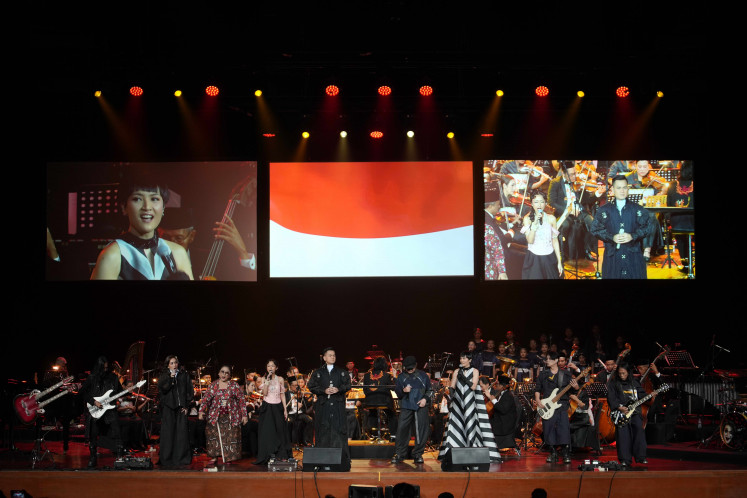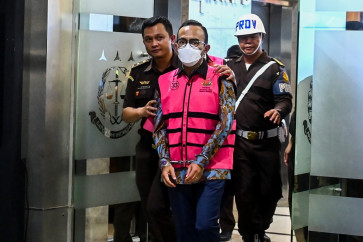Popular Reads
Top Results
Can't find what you're looking for?
View all search resultsPopular Reads
Top Results
Can't find what you're looking for?
View all search resultsPerformance arts see fewer shows, higher appreciation
Gandari dance opera: (JP/Ricky Yudhistira)As capital owners sat back and watched the political situation during the election year, so did performance art producers
Change text size
Gift Premium Articles
to Anyone
 Gandari dance opera: (JP/Ricky Yudhistira)" height="400" width="600" border="0">Gandari dance opera: (JP/Ricky Yudhistira)
Gandari dance opera: (JP/Ricky Yudhistira)" height="400" width="600" border="0">Gandari dance opera: (JP/Ricky Yudhistira)As capital owners sat back and watched the political situation during the election year, so did performance art producers.
In a country where its artists rely much on financial donors, slight tension in politics could result in fewer shows throughout the year.
That was the case in Indonesia, which only had 13 shows at theaters in Jakarta this year, a rare occasion compared to around 25 shows last year in the city alone. In 2012, there were up to 40 performances in total in Jakarta, Yogyakarta and Bali.
Stage manager Toto Arto, who had been involved in many performing arts projects, such as Kingâs Witch, Kali, Tan Malaka, I La Galigo and the Laskar Pelangi musical, said that time scheduling was also a problem.
Safety and fear of propaganda, according to Toto, were among the issues faced in obtaining a crowd permit.
As the result, most of the shows were held in the first and last quarters of the year and some of them had to be held very close to each other.
âWeâve seen art festivals held at the same time to adjust to the election schedule,â he said, citing an example of the biennial Salihara Festival from Sept. 13 to Oct. 22, which was soon followed by the Indonesian Dance Festival and the Jakarta Arts Institute (IKJ) International Festival.
However, that was not the case at smaller theaters such as in Komunitas Salihara art and cultural center in South Jakarta, and the Galeri Indonesia Kaya art and cultural gallery in Central Jakarta.
The gallery recorded 328 performance events at its small theater during the first year of its existence from October 2013 to November 2014.
 Wayang Orang Rock Ekalaya: (JP/Jerry Adiguna)
Wayang Orang Rock Ekalaya: (JP/Jerry Adiguna)
The shows were held regularly on weekends and, when there were requests for more shows, sometimes on weekdays.
The gallery project director Renitasari Adrian said that performance arts has been the main focus âbecause it will help out many more creative people compared to other forms of artâ.
She said that the production process for each stage usually involved 20 to 30 people, including the artists and production crew.
Galeri Indonesia Kaya provided free facilities, stage props and promotion for each performance at the theater.
âThe artists should only focus on their performance. If they want to perform at bigger venues, we will partly fund the productions and handle the promotion of the event,â Renita said.
The gallery, managed by the Djarum Foundation â the charity wing of cigarette producer Djarum, has seen a steady increase of visitors.
As of November, over 110,000 people have visited the multifunction public space inside Grand Indonesia shopping mall.
Forty-two percent of the visitors are between 12 and 25 and 32 percent are between 26 and 45 years old.
âOur goal in five years is drawing the public closer to the arts by presenting quality performances. To achieve that, we also act as curators for budding theater groups and hold discussions after performances by renowned groups so that both the public and the young artists can learn more about the arts.â
If 2013 was dubbed as the awakening year of performance arts, this year witnessed improvement in production quality and higher public appreciation.
Although there was no official data on the number of paying audience members at the Jakarta Playhouse and Taman Ismail Marzukiâs theaters or at the venues inside the Bung Karno sports center in Senayan â all in Central Jakarta â there were reports of full houses especially for weekend shows, regardless of the genre.
Renowned troupe Teater Koma staged two big-scale shows this year â Demonstran (The Protestor) in March and Republik Cangik (Cangikâs Republic) in November â in its conventional format of satire.
Gandari dance opera: (JP/Ricky Yudhistira) As capital owners sat back and watched the political situation during the election year, so did performance art producers. In a country where its artists rely much on financial donors, slight tension in politics could result in fewer shows throughout the year. Wayang Orang Rock Ekalaya: (JP/Jerry Adiguna) Teater Koma's Republik Cangik: (Courtesy of Tribunnews/Dany Permana)
That was the case in Indonesia, which only had 13 shows at theaters in Jakarta this year, a rare occasion compared to around 25 shows last year in the city alone. In 2012, there were up to 40 performances in total in Jakarta, Yogyakarta and Bali.
Stage manager Toto Arto, who had been involved in many performing arts projects, such as King's Witch, Kali, Tan Malaka, I La Galigo and the Laskar Pelangi musical, said that time scheduling was also a problem.
Safety and fear of propaganda, according to Toto, were among the issues faced in obtaining a crowd permit.
As the result, most of the shows were held in the first and last quarters of the year and some of them had to be held very close to each other.
'We've seen art festivals held at the same time to adjust to the election schedule,' he said, citing an example of the biennial Salihara Festival from Sept. 13 to Oct. 22, which was soon followed by the Indonesian Dance Festival and the Jakarta Arts Institute (IKJ) International Festival.
However, that was not the case at smaller theaters such as in Komunitas Salihara art and cultural center in South Jakarta, and the Galeri Indonesia Kaya art and cultural gallery in Central Jakarta.
The gallery recorded 328 performance events at its small theater during the first year of its existence from October 2013 to November 2014.
The shows were held regularly on weekends and, when there were requests for more shows, sometimes on weekdays.
The gallery project director Renitasari Adrian said that performance arts has been the main focus 'because it will help out many more creative people compared to other forms of art'.
She said that the production process for each stage usually involved 20 to 30 people, including the artists and production crew.
Galeri Indonesia Kaya provided free facilities, stage props and promotion for each performance at the theater.
'The artists should only focus on their performance. If they want to perform at bigger venues, we will partly fund the productions and handle the promotion of the event,' Renita said.
The gallery, managed by the Djarum Foundation ' the charity wing of cigarette producer Djarum, has seen a steady increase of visitors.
As of November, over 110,000 people have visited the multifunction public space inside Grand Indonesia shopping mall.
Forty-two percent of the visitors are between 12 and 25 and 32 percent are between 26 and 45 years old.
'Our goal in five years is drawing the public closer to the arts by presenting quality performances. To achieve that, we also act as curators for budding theater groups and hold discussions after performances by renowned groups so that both the public and the young artists can learn more about the arts.'
If 2013 was dubbed as the awakening year of performance arts, this year witnessed improvement in production quality and higher public appreciation.
Although there was no official data on the number of paying audience members at the Jakarta Playhouse and Taman Ismail Marzuki's theaters or at the venues inside the Bung Karno sports center in Senayan ' all in Central Jakarta ' there were reports of full houses especially for weekend shows, regardless of the genre.
Renowned troupe Teater Koma staged two big-scale shows this year ' Demonstran (The Protestor) in March and Republik Cangik (Cangik's Republic) in November ' in its conventional format of satire.
Fans thronged to the theaters either for the story ' of which the troupe was famous, the seasoned actors/actresses or the meticulously designed stage set.
Collaborative works of diverse forms of arts, however, dominated this year's shows.
Wayang Orang Rock Ekalaya, for instance, was a blend of the Maha-bharata, a video game and a rock musical, performed by rock musicians.
A Broadway-like performance, Siti Nurbaya: Kasih tak Sampai (Siti Nurbaya: Unrequited Love), also integrated stunts from parkour or freerunning practitioners and illusion tricks.
Yola Yulfianti's dance opera I Think ... Tonk in September integrated lighting designs and video footage in narrating the story of Jakartan urban life.
The performance that closed the year, dance opera Gandari, introduced to the public contemporary classical music that has stayed in the background of the country's music scene for long time. Not only was the performance a blend of interdisciplinary forms of art, it was also a collaborative work of world performers from Indonesia, the Netherlands and Japan.
Toto said that this year could be the start of performing artists to take their works to stage and no longer hid behind the excuse of how segmented their works were.
'Arts need public appreciation and money should not be a problem anymore. What makes this year significant is the existence of private entities concerned with developing culture and arts and not expecting profits from them. Artists should utilize this opportunity,' he said.
Your Opinion Matters
Share your experiences, suggestions, and any issues you've encountered on The Jakarta Post. We're here to listen.
Thank You
Thank you for sharing your thoughts. We appreciate your feedback.
Share options
Quickly share this news with your network—keep everyone informed with just a single click!
Gift Premium Articles
to Anyone
Share the best of The Jakarta Post with friends, family, or colleagues. As a subscriber, you can gift 3 to 5 articles each month that anyone can read—no subscription needed!
Continue in the app
Get the best experience—faster access, exclusive features, and a seamless way to stay updated.











